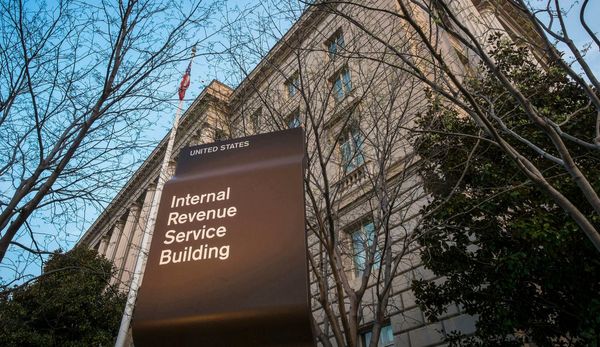Inflation is the watchword on Wall Street this week, with the U.S. inflation rate soaring to 8.5% in March – the highest in 40 years.
Now, TheStreet’s Tom Graff is wondering if inflation and the economy, which have both been burning up, are burning out right now.
“The Federal Reserve has only hiked interest rates by a quarter of a percentage point off zero, and yet we're seeing nascent signs of slowing,” Graff said. “We saw this early this week, when, despite an 8.5% consumer price index increase year-over-year, the bond yields fell and bets on Fed rate hikes in 2023 subsided.”
The markets have been hearing for a couple weeks that trucking freight volumes were declining.
“Logistics data provider FreightWaves tracks both volumes and cancellations, which can be a sign of how tight capacity is,” Graff noted. “Both are showing softness in March. Freight can be hyper-cyclical, however, which is to say it can have severe ups and downs, even as the rest of the economy stays steady.”
This scenario could also be a sign that companies have built up more inventory than they want, possibly because they overbuilt or overbought leading up to this point. “Or, it could be because they see consumption slowing down,” Graff said
Two additional data points to support the idea that maybe things are slowing a bit.
“The first was CarMax's (KMX) earnings report, where it said that used car sales volume dropped by 6.5% last quarter,” Graff said. “Given how large CarMax is, that is a very telling data point about the broad used car market. That could be a sign that a combination of higher prices and higher interest rates are starting to crimp demand for large ticket items.”
The other data point came from the CPI itself.
“While the headline year-over-year number was an eye-watering 8.5%, the details gave a more nuanced story,” he added. “Excluding food and energy, CPI only increased 0.3% in March, which was below consensus. Moreover, looking at goods prices only, overall prices actually fell by 0.4%, and every major category of goods prices decelerated from February.”
While noting that economic activity never moves in a straight line, Graff notes that some softening may be good for stocks.
“If inflation were to incrementally slow, indicating that Fed policy and guidance are having an effect, that would probably be good news for equities,” he said. “While it would probably still mean the Fed hikes several times in 2022, it might mean that hikes stop by 2023. If so, that would lower the odds that the Fed hikes well beyond some number the economy can handle, and thus lower the risk of a stagflation scenario. All that should boost stocks.”
Even as inflation burns, and as the economy feels the flames, there are some intriguing market opportunities right now. The Street’s trading experts lead the way with these “buy the dip” stocks this week.
Lyft $35.22. 5-day performance 2.69%.
Lyft (LYFT) appears to be sending mixed messages to investors of late, but the long-term outlook is promising.
“It's not hard to see how Lyft could do well in an environment featuring healthy GDP growth, high inflation, rebounding corporate travel, and a shift in discretionary consumer spending from goods to travel, dining and entertainment,” TheStreet’s Eric Johnsa said.
Yet for now, the ride-sharing duopolist's stock price -- down 19% year-to-date and 44% over the last 12 months as of the time of this article -- doesn't reflect these positives nearly as much as it should.
A few different factors appear to have weighed on Lyft's shares lately.
“Perhaps the biggest ones: Lyft -- along with archrival Uber (UBER) -- has been contending with driver shortages that have boosted its ride prices and led it to spend more [on] driver-acquisition incentives,” Johnsa said. “Consequently, shares of both companies have been pressured by a broader selloff in growth tech stocks that has hit unprofitable and lightly profitable companies especially hard.”
In addition, Lyft and Uber's shares appear to have been dinged by worries that the Fed's actions will soon trigger a major economic downturn. And more recently, worries (also likely overblown, given what current ride-sharing pricing is like) about the impact of higher gas prices on ride-sharing activity have been a headwind.
“All of this has apparently led many investors to overlook how ride-sharing activity is poised to surge in the coming months, as consumers get out more and office re-openings pick up,” Johnsa said. “Both JPMorgan Chase (JPM) and Delta Air Lines (DAL) indicated on their Wednesday earnings calls that they're seeing a strong uptick in proverbial reopening activity among consumers. And one only has to look at Google's mobility data or OpenTable's restaurant reservation data to see how there are still major regional disparities in reopening activity that are likely to normalize over time.”
Meanwhile, ride-sharing driver shortages have been gradually easing.
On its fourth-quarter earnings call, Lyft disclosed that new driver activations were up nearly 50% annually, and that driver incentives equaled just 3% of revenue. The March jobs report also suggests that (although the labor market definitely remains tight) we're seeing an uptick in services sector labor availability.
“And while driver shortages have led ride prices to be higher than what Lyft would prefer them to be, they haven't hurt demand as much as one might think,” Johnsa added. “Lyft's active riders rose 49% annually in Q4 to 18.7 million (admittedly, still below a Q4 2019 high of 22.9 million), even as its revenue per active rider rose 14% to $51.79. To an extent, Lyft and Uber are (like various other online platforms/marketplaces that take a transaction cut) proving to be inflation beneficiaries.”
So why should investors pick Lyft over Uber? One good argument for doing so is that Lyft is far more of a U.S. reopening pure-play than Uber is.
“Uber has, in recent quarters, been getting over half its gross bookings from its food-delivery segment, and it gets over 40% of its revenue from outside of North America, with a portion of these sales coming from markets with relatively challenging macro environments,” Johnsa noted. “Lyft, by comparison, gets nearly all of its revenue from transportation services provided in the U.S. and Canada (the company does have a white-label food-delivery service, but it's in its early stages and doesn't appear to be a major revenue contributor yet).”
Just as importantly in the current market environment, Lyft (aided by restructuring efforts it carried out in 2020) appears to be running itself more efficiently than Uber, in spite of its smaller scale.
“Whereas Uber is expected to lose money again this year, the FactSet consensus is for Lyft to generate $242 million in operating income this year, followed by $597 million next year,” Johnsa added.
Charles Schwab SCHW $82.81. 5-day performance 3.40%.
Investors looking for a stock that benefits from higher interest rates - which certainly are a reality right now – may benefit from one of Wall Street’s biggest names.
“I've been looking for stocks that might benefit from higher interest rates and came across some research this morning from Morgan Stanley, which names Charles Schwab (SCHW) a "Top Pick”, said TheStreet’s James “Rev Shark” Deporre. “The analyst believes that SCHW is one of the most interest-rate-sensitive stocks in the market and, unlike banks, it does not have credit risk.”
According to Rev Shark, brokers such as Schwab no longer need to charge commissions for stock trades because they make big money from margin lending and cash sweeps.
“Higher interest rates are just pure profits in this situation,” Deporre said. “Morgan Stanley has a price target on SCHW stock of $132 versus the current price of around $82.”
Schwab reported earnings on April 18 that proved disappointing, sending shares down sharply. It had been sitting on support at its 200-day simple moving average and trading at a 25 P/E with expected EPS growth of about 25% per year based on current estimates.”
Deporre said he started the position Wednesday morning and will be looking to “add to it as it develops.”
Kimberly-Clark KMB $126.50. (-) 0.21%.
TheStreet’s Bob Ciura says that the economy and the stock market are being peppered with curve balls right now, and the best antidote to that are stocks with high dividend yields.
He has a few ideas on that front.
“The stock market has been getting some arrows flung at it so far in 2022,” Ciura said. “We're getting hit by rising interest rates; inflation and supply chain constraints that squeeze industrials and retailers and consumers; and we have a distinct fear of recession for 2022 or 2023, as the U.S. comes off of a period of unprecedented growth out of the Covid-induced recession.”
Despite all of these factors, U.S. consumers remain in very good shape, as unemployment is back near historical lows, consumer spending remains robust, and housing prices have soared.
“All of the above support the idea that the consumer in the U.S. is likely to continue to support certain sectors of the economy, with consumer staple stocks being an obvious choice,” he added. “This group offers generally consumable products that are low-cost, and typically have some sort of necessity for consumers.”
One such stock that should stand to do well in this economy is Kimberly-Clark (KMB) , a highly diversified consumer and professional personal care company that operates globally.
Kimberly-Clark makes a variety of consumable personal care products such as diapers, feminine care products, wipes, tissues, paper towels, soaps, and more. Kimberly-Clark is a true consumer staple stock in that the products it provides are necessary and have little to no discretionary use.
“The company was founded in 1872, generates about $20 billion in annual revenue, and trades with a market cap of $42 billion,” Ciura said. “The stock recently became a Dividend King with its 50th consecutive annual dividend increase, and the yield is quite attractive as well at 3.7%.”
The combination of the high yield -- which is almost three times that of the broader market -- as well as the five decades of dividend increases makes Kimberly-Clark a “terrific” income stock.
“The payout ratio is somewhat elevated at 77%, but given the highly predictable nature of the company's revenue and earnings, we don't see the dividend as under threat,” Ciura added.
Altria MO $54.90. 5-day performance 2.33%.
Another stock Ciura likes right now is Altria (MO), the tobacco giant that manufactures and sells well-known brands such as Black & Mild, Skoal, and Marlboro.
“Altria was once a pure play on tobacco, offering cigarette and smokeless tobacco brands in the U.S., but it has recently attempted to diversify away from cigarettes with its vaping and smokeless products,” Ciura noted. “For now, however, Altria remains a tobacco company and it exhibits the characteristics of one.”
The company was founded in 1822, and it generates about $21 billion in annual revenue, and trades with a $98 billion market cap. Altria's dividend increase streak is 52 years, and it yields a substantial 6.6%.
“That's the sort of yield generally reserved for business development companies or real estate investment trusts, but Altria returns a huge amount of cash to shareholders, making it a dividend investor favorite,” Ciura said. “Like Kimberly-Clark, its payout ratio is somewhat elevated at 79%, but again, given the predictability of its earnings, we don’t see the impressive dividend as being at risk in the next few years, at least.”







